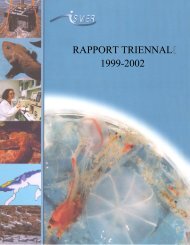Wind-driven coastal circulation in the Gulf of Tehuantepec, Mexico ...
Wind-driven coastal circulation in the Gulf of Tehuantepec, Mexico ...
Wind-driven coastal circulation in the Gulf of Tehuantepec, Mexico ...
Create successful ePaper yourself
Turn your PDF publications into a flip-book with our unique Google optimized e-Paper software.
Ciencias Mar<strong>in</strong>as, Vol. 37, No. 4A, 2011high chlorophyll a concentrations and low temperatures(Müller-Karger and Fuentes-Yaco 2000, McCla<strong>in</strong> et al. 2002,González-Silvera et al. 2004). The effects produced by aw<strong>in</strong>d event basically consist <strong>of</strong> an <strong>of</strong>fshore drag accompaniedby a decrease <strong>in</strong> sea level near <strong>the</strong> shore. A pair <strong>of</strong> eddies <strong>of</strong>opposite sign <strong>the</strong>n form on both sides <strong>of</strong> <strong>the</strong> w<strong>in</strong>d jet (Lavínet al. 1992). Satellite imagery and <strong>in</strong> situ measurements haverevealed important differences between <strong>the</strong> eddies generated(Barton et al. 1993, Trasviña et al. 1995, Müller-Karger andFuentes-Yaco 2000, González-Silvera et al. 2004). The anticycloniceddy that forms on <strong>the</strong> west side <strong>of</strong> <strong>the</strong> w<strong>in</strong>d jet isgenerally more <strong>in</strong>tense, smaller <strong>in</strong> diameter, and lasts longerthan <strong>the</strong> cyclonic eddy that forms on <strong>the</strong> east side and whichis not always visible. McCreary et al. (1989) expla<strong>in</strong> that thisasymmetry is due to an entra<strong>in</strong>ment <strong>of</strong> cold water on <strong>the</strong> side<strong>of</strong> <strong>the</strong> cyclonic eddy. Even though <strong>the</strong> results obta<strong>in</strong>ed byClarke (1988) show a symmetric response <strong>of</strong> <strong>the</strong> ocean, thisauthor suggests that <strong>the</strong> anticyclonic eddy is <strong>in</strong>tensified by<strong>the</strong> negative vorticity produced by <strong>the</strong> <strong>in</strong>ertial w<strong>in</strong>d path.Though differences have been detected <strong>in</strong> <strong>the</strong> dynamicresponse <strong>of</strong> surface currents to Tehuanos, to date <strong>the</strong>re are noreports that discuss <strong>the</strong> physical mechanisms caus<strong>in</strong>g <strong>the</strong>asymmetric response <strong>of</strong> <strong>the</strong> ocean on both sides <strong>of</strong> <strong>the</strong> w<strong>in</strong>djet. Our observations <strong>in</strong>dicate that <strong>the</strong> presence <strong>of</strong> a <strong>coastal</strong>current dur<strong>in</strong>g w<strong>in</strong>ter is one <strong>of</strong> <strong>the</strong> ma<strong>in</strong> causes <strong>of</strong> this asymmetry.The role played by <strong>the</strong> w<strong>in</strong>d stress component parallelto <strong>the</strong> coast and w<strong>in</strong>d stress divergence <strong>in</strong> <strong>the</strong> local dynamicsis also exam<strong>in</strong>ed.In this study we analyze <strong>the</strong> effect <strong>of</strong> w<strong>in</strong>d on sea surface<strong>circulation</strong> based on high-frequency radar measurements <strong>of</strong>surface currents taken <strong>of</strong>f <strong>the</strong> coast <strong>of</strong> Oaxaca betweenFebruary and April 2005. We exam<strong>in</strong>e <strong>the</strong> temporal evolution<strong>of</strong> surface velocity fields and analyze <strong>the</strong> effects caused bystrong local w<strong>in</strong>ds on <strong>the</strong> <strong>coastal</strong> dynamics. We first show <strong>the</strong>results <strong>of</strong> <strong>the</strong> ocean current observations toge<strong>the</strong>r with <strong>the</strong>w<strong>in</strong>d and sea surface temperature observations. We <strong>the</strong>nshow <strong>the</strong> spatial relationship between <strong>the</strong> w<strong>in</strong>d stress and surfacecurrent variables. F<strong>in</strong>ally, we show <strong>the</strong> comb<strong>in</strong>ed results,compar<strong>in</strong>g representative series <strong>of</strong> <strong>the</strong> w<strong>in</strong>d variables and <strong>the</strong>spatial density <strong>of</strong> k<strong>in</strong>etic energy and relative vorticity.MEASUREMENTS AND DATAFor this study we used <strong>the</strong> Cross-Calibrated, Multi-Platform (CCMP) Ocean Surface <strong>W<strong>in</strong>d</strong> Velocity Product(H<strong>of</strong>fman 1984, Atlas et al. 1996). This product provideszonal and meridional w<strong>in</strong>d component data at 6-h <strong>in</strong>tervals,with a spatial resolution <strong>of</strong> 25 km. We also used measurements<strong>of</strong> sea surface temperature from <strong>the</strong> GeostationaryOperational Environmental Satellite (GOES) product (JPLPhysical Oceanography Distributed Active Archive Center).This product provides daily images with a spatial resolution<strong>of</strong> ~5.5 km. To study <strong>the</strong> spatial and temporal variability <strong>of</strong><strong>coastal</strong> <strong>circulation</strong> <strong>in</strong> <strong>the</strong> GT, high-frequency radar (HFR)systems (16-element phased array) were <strong>in</strong>stalled at two sitesEn varios estudios se ha registrado la formación deremol<strong>in</strong>os de mesoescala, que se identifican en imágenessatelitales como zonas de alta concentración de clor<strong>of</strong>ila a ybaja temperatura (Müller-Karger y Fuentes-Yaco 2000,McCla<strong>in</strong> et al. 2002, González-Silvera et al. 2004). La explicaciónbásica de los efectos producidos por un evento deviento consiste en un arrastre hacia afuera de la costa, acompañadode una dism<strong>in</strong>ución en el nivel del mar junto a lacosta. Posteriormente, se forma un par de remol<strong>in</strong>os de signocontrario en ambos lados del chorro de viento (Lavín et al.1992). Las evidencias obtenidas de imágenes satelitales y demediciones <strong>in</strong> situ muestran diferencias importantes entre losremol<strong>in</strong>os generados (Barton et al. 1993, Trasviña et al.1995, Müller-Karger y Fuentes-Yaco 2000, González-Silveraet al. 2004). El remol<strong>in</strong>o anticiclónico que se forma al oestedel chorro de viento es generalmente más <strong>in</strong>tenso, de menordiámetro y más longevo que el remol<strong>in</strong>o ciclónico que seforma en la zona este y que no siempre es visible. McCrearyet al. (1989) explican que esta asimetría se debe al abordamientode agua fría en el lado del remol<strong>in</strong>o ciclónico. Aúncuando sus resultados muestran una respuesta simétrica delocéano, Clarke (1988) sugiere que la <strong>in</strong>tensificación delremol<strong>in</strong>o anticiclónico se debe a que la trayectoria <strong>in</strong>ercialdel viento <strong>in</strong>troduce vorticidad negativa.En resumen, se han reconocido las diferencias de la respuestad<strong>in</strong>ámica de la corriente superficial a los tehuanos; s<strong>in</strong>embargo, a la fecha no existen estudios que discutan losmecanismos físicos que causan la respuesta asimétrica delocéano a ambos lados del chorro de viento. Las observacionesque se reportan en el presente trabajo permiten suponer,como primer punto, que la presencia de una corriente costeradurante el <strong>in</strong>vierno es una de las pr<strong>in</strong>cipales causas de estaasimetría. Adicionalmente, se exam<strong>in</strong>a el papel que juegan lacomponente del esfuerzo del viento paralela a la costa y ladivergencia del esfuerzo del viento sobre la d<strong>in</strong>ámica local.En este trabajo se estudia el efecto del viento sobre lacirculación superficial del océano a partir de mediciones decorrientes superficiales con sistemas de radar de alta frecuenciaobtenidas en la costa de Oaxaca entre febrero y abril de2005. Se estudia la evolución temporal de los campos develocidad superficial y se analizan los efectos causados porlos vientos locales fuertes sobre la d<strong>in</strong>ámica costera. Como<strong>in</strong>icio, se muestran los resultados de las observaciones decorrientes en conjunto con observaciones de viento y temperaturasuperficial. Posteriormente, se muestra la relaciónespacial entre las variables del esfuerzo del viento y las variablesde la corriente superficial. F<strong>in</strong>almente, se muestran todosestos resultados de forma <strong>in</strong>tegral, mediante la comparaciónde series representativas de las variables del viento y ladensidad espacial de energía c<strong>in</strong>ética y de vorticidad relativa.MEDICIONES Y DATOSPara este trabajo se utilizaron las mediciones satelitalesde la velocidad del viento sobre la superficie del océano444




